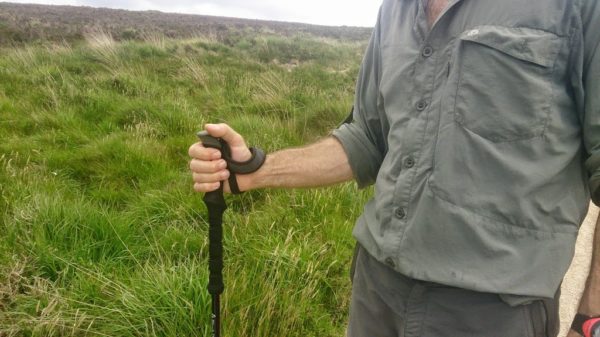Hill Skills Series – Top Tips for using Walking Poles

Many hikers use walking poles when out in the hills, and with good reason. They help maintain balance, reduce the impact on our knees hips and ankles, (particularly in descent and when carrying a heavy pack), and are a useful support on slippery ground and when negotiating a river crossing.
Using poles will also give you more of a full body workout, by exercising the upper body as well as the legs.
Unfortunately, some folk using walking poles gain little of these benefits because they are either using them incorrectly or they are incorrectly adjusted.
Walking poles are often placed too far out in front or too far to the side of the body, and they are often set at the wrong length for the height of the user.
Some hikers will prefer to use their poles continuously throughout the day, but there are occasions when they can be more of a hindrance than a help, when moving through thick vegetation or scrambling up rocky terrain, for example.
By making slight adjustments to the way they use their walking poles, many more people would get the full benefit of their use when out hiking.
Here are my top tips for getting the most out of using your walking poles:
- With your hand on top, adjust the length so that your elbow is at a right angle and your forearm is horizontal or at a slight downward angle (this is an advantage when the weather is cold as it improves circulation to your hands and keeps them warmer).
- Putting your hand through the wrist loop before you grip the pole will put less strain on your wrist. However it can be hard to get your hand out of the loop if you take a fall, some experienced users now find it preferable to place the hand over the pommel at the top, so that if you fall the pole will drop away from you and not flail around with the potential to do injury.
- It is preferable to use two poles rather than one, on it’s own a pole can cause imbalance and muscle strain or injury. However, one pole can offer advantages in winter when an ice axe is held in the other hand for security.
- As you walk place each pole and opposite foot on the ground together, i.e. left foot and right hand pole. This will make for more efficient and comfortable movement.
- Try to angle the pole so the top is slightly ahead of the bottom, this will give you a good forward thrust action, rather like a ski pole. This action will take some of the hard work out of your legs and will improve your core and upper body strength for a full body work out.
- Using poles can be difficult on terrain where secure placement is difficult, e.g. deep heather or rocky ground. If you need to use your hands on a scrambly section it is advisable to pack the poles away on your rucksack.
- Shorten the poles on steep ascents, (or grip them lower down the shaft) and lengthen the poles slightly for long and steep descents, flick locking poles make this easier than the older twist locking system.
- In ascent use them to the side or slightly behind you, this will give added propulsion up the slope. On a steep descent, place them ahead of you, for support and braking. This can take a lot of the pressure off your leg joints and works well if you have sore knees or hips.
- Poles can become a trip hazard for you and those around you when not in use and should be put away when you are not using them.
- Rubber tips on walking poles are meant for use on roads and they often come off when out in the hill, please leave them at home.
- A ‘snow basket’ on the bottom of your pole will stop it sinking into soft snow or boggy ground, but they can become a trip hazard in heavy vegetation so keep them for winter use.
- Be prepared to put your poles away when navigating with your map and compass.
- Flick lock poles are quicker and easier to adjust than the twist tightening types, and are less prone to freezing in cold winter weather.
- In winter conditions, walking poles are not a substitute for an ice axe and if you find yourself on frozen ground then be prepared to get out your axe.
Russ Mills runs Mountaintrails, a guided hiking and skills training outdoor provider based in Dublin. To find out more go to Mountaintrails.ie.
